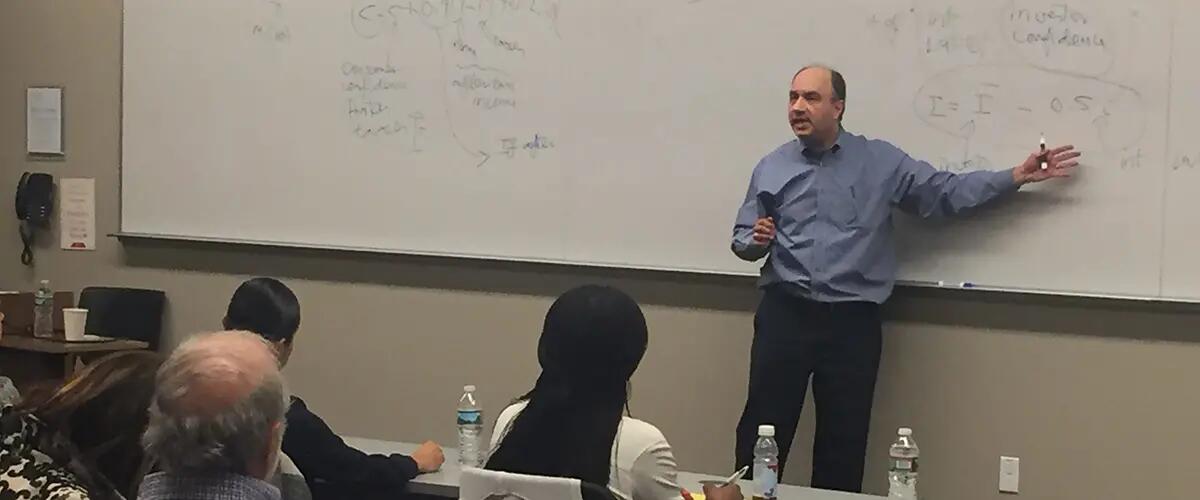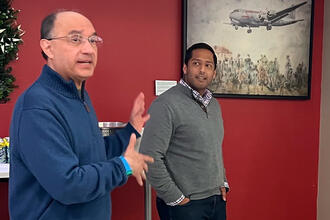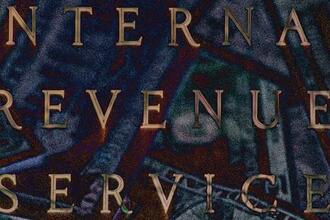
The debt mess and a roadmap out of the crisis
By Farrokh Langdana, Director, Executive MBA Program & Professor of Finance and Economics
Faculty Blog: macrobuddies.blogspot.com
We are now using the not-so-subtle debt downgrade by S&P to hit our policymakers over the head with the fact that we have to get the deficits back into the sustainable zone and put our political house in order. So maybe something good will come out of the downgrade.
The key issue is whether the downgrade will result in a loss of the US’s “safe haven” status. The answer, for now, is no. Capital still stormed into the relatively safe haven offered by US sovereign debt (Treasuries) the day after the downgrade. But this does not mean that we can rest assured that we will remain the safest haven. We are competing for that status with Switzerland, and several Asian economies (Singapore, for example) that have experienced sharp spikes in their currencies as capital has flooded in seeking an alternate safe haven to the US.
The budget deficits, both here and in Europe, are poised to get larger very fast. This is not only because of rapid increases in spending, but due to the impending sharp drop in the tax base.
[Note that budget deficits are G-T > 0. Here, T is tax revenues, given by T = tY, where “t” is the tax rate, and Y is national income. If national incomes (Y) fall here and in Europe as the mature economies sink into a slowdown or another recession, the tax revenues (T) will fall fast, and as unemployment benefits (G) increase, the deficits will shoot up rapidly.]
It is a well established fact that deficits rise fast in recessions, and shrink rapidly in recoveries. Bottom line is that the deficit mess will be bigger very soon.
QE3? Again, best not to fixate on titles. The fact is that the Fed is already doing a version of “QE3” in the form of rampant monetization of our budget deficits, described by Rutgers EMBA student, Dr. Jesse Cohen, as “stealth monetization.” Clearly we are spending more than what the Government receives in the form of tax revenues and by borrowing from China and Brazil and Japan. This shortfall between government spending and capital inflows + tax revenues + domestic lending is “financed” simply by monetization, which is a fancy word for printing money.
Back in 2009, we saw how “Keynes was Tired”, and the Supply-sider model was stymied.
Well, it’s 2011 and nothing has changed.
So what to do?
The President has to be in charge. He has to step up and to finally act like a leader. He needs to manage expectations for the masses. Right now we have an obviously massive crisis in confidence – both consumer confidence and investor confidence (C-bar and I-bar). He needs to exhort Congress with a sense of urgency to finally solve this debt mess immediately.
For the long term, he has to announce a macro policy in broad brush terms. We need less regulation on companies that were not responsible for the subprime mess. (Note: Adam Smith never said “no regulation.” He advocated some minimal regulation to prevent malfeasance, followed by the “invisible hand” then taking over to usher in prosperity.)
The President needs to shut down tax loopholes for exporters – Ricardian trade (comparative advantage for each trading partner) is powerful enough to succeed without the tail-wind of additional tax benefits. He needs to make America safe for an innovation breakthrough by recreating an economic ecosystem that will breed new products and services. To achieve this he must implore congress to enact broad-based tax cuts for innovation.
He needs to follow-up on the results of the investigations into the financial improprieties that caused the subprime mess. Main Street USA wants to see a hanging – at least one. Granny (with her savings account paying 0%) was indeed taken to the cleaners by Goldman (who borrowed at 0% thanks to the Fed, and lent at 6% and then rewarded itself). This has got to be resolved. That festering blister has got to be lanced.
The President needs to remind us of the past crises through which we as a country have persevered. He needs to tell us plainly that we have our back against the wall; that the world is watching to see what we Americans are made of. Will we be as tough as the Great Depression Generation?
He needs to challenge us. He needs to challenge CEOs to do the right thing. Will there be even one CEO who will say, “I just cannot see the rationale of my salary being so obscenely out of whack with my employees? Hence, I volunteer to cut back for the next year to something that smacks remotely of decency.” The CEO who first breaks ranks in such a way will be a national hero.
For that is what we are missing in this crisis. In every American crisis so far, there has emerged a savior, a natural leader. Heroes like Washington, Lincoln, Roosevelt, Kennedy, and Reagan. This time the silence is deafening.
Press: For all media inquiries see our Media Kit


